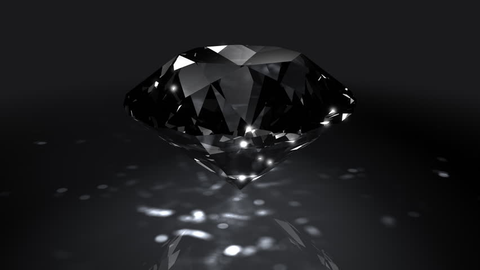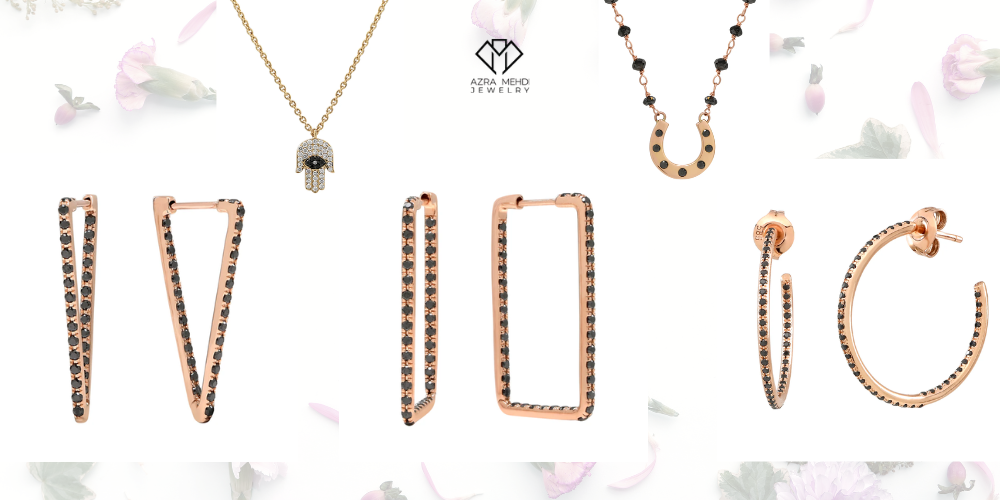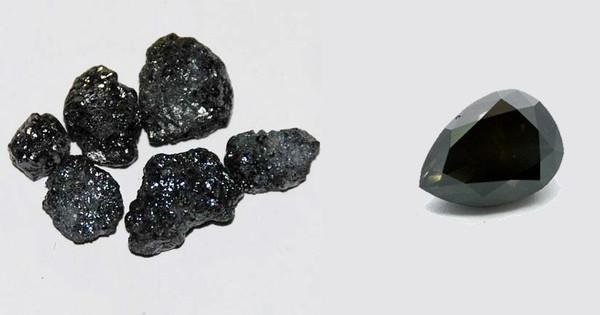
Black diamonds offer a distinctive alternative to traditional white diamonds, appealing to those seeking jewelry that makes a bold statement or offers a modern twist. But, what are black diamonds really? Let’s take a deeper dive into the world of black diamonds to become a well-informed buyer.
What Makes Black Diamonds Black?
The color of black diamonds comes from natural processes involving inclusions and graphitization, or by treating lower-quality white diamonds.
Natural or fancy black diamonds, also known as Carbonados, have their color because of a multitude of dense inclusions, primarily graphite, in the diamond which give it a black appearance. Natural black diamonds that have an almost metallic look get their color from mineral inclusions like pyrite or hematite and a graphitization of fractures within the stone.
Treated black diamonds start as white diamonds with massive and numerous inclusions. These diamonds undergo irradiation or heat treatment causing the inclusions to alter in color turning the diamond black. This is a great way to enhance diamonds that would otherwise be of lower value.
Finally, although it is possible to create synthetic or lab-grown black diamonds, there isn't a significant market for them because they are expensive to make , and not as valuable as other lab-grown diamonds, like blue or pink diamonds.
Black vs. White . . . How Are Black Diamonds Different from White Diamonds?
Aside from the obvious difference in color, black diamonds differ significantly from traditional white diamonds in several ways.
Appearance
- Color: Black diamonds are opaque and black, while white diamonds are known for their translucent to transparent nature and can range from colorless to light yellow or light brown.
- Brilliance: White diamonds are prized for their ability to refract light, showcasing brilliance and fire. Black diamonds, being opaque, do not refract light but have a unique, metallic luster that gives them a sleek and modern appearance.
- Inclusions: Black diamonds are polycrystalline and consist of crystals in random orientation. They owe their black color primarily to graphitic inclusions and, to a lesser extent, to other minerals. In contrast, the color and clarity of white diamonds are affected by the presence of nitrogen atoms and structural imperfections.
Physical Properties
- Formation: Some theories suggest black diamonds formed in space and arrived on Earth via meteorites, contrasting with the deep-earth formation of white diamonds.
- Hardness: Both black and white diamonds score a 10 on the Mohs scale of hardness, making them the hardest natural materials on Earth. The numerous inclusions and polycrystalline structure make black diamonds more challenging to cut and polish.
- Density: Black diamonds are denser than white diamonds due to their unique structural composition, affecting their weight compared to size ratio.
Value and Market
- Rarity: White diamonds are more common than natural black diamonds, although treated or enhanced black diamonds are widely available and more affordable.
- Price: The value of white diamonds is determined by the 4Cs (Cut, Color, Clarity, and Carat weight), with colorless and flawless diamonds being the most valuable. Black diamonds do not follow this pricing structure strictly since they are assessed more on their overall appearance and carat weight, rather than clarity and color gradation.
- Market Demand: White diamonds have traditionally dominated the jewelry market, symbolizing purity and status. However, black diamonds have gained popularity for their bold and unconventional beauty, often featured in contemporary jewelry designs and favored for their unique aesthetic appeal.
How Does the Price of Black Diamonds Compare to White Diamonds?
The price of black diamonds compared to white diamonds varies significantly depending on whether the black diamonds are natural or treated.
Treated black diamonds are generally more readily available and hence more affordable than both natural black diamonds and many white diamonds because treated black diamonds are typically lower quality white diamonds that have undergone treatments like heating or irradiation to alter their color to black. These treatments make otherwise less desirable diamonds more marketable.
Gem quality natural black diamonds (Carbonados) that can be used in jewelry are quite rare, making them very valuable, often comparable to or exceeding the price of mid-range white diamonds.
The pricing of white diamonds is heavily influenced by the 4Cs—cut, color, clarity, and carat weight. Top-quality white diamonds, especially those that are colorless and flawless, are priced at a premium. The clarity and sparkle of white diamonds are highly prized, and their pricing reflects this.
For buyers looking for a unique, dark aesthetic without breaking the bank, treated black diamonds offer a cost-effective solution.
For collectors and those looking for an investment, natural black diamonds offer rarity that may hold or increase in value, much like high-quality white diamonds.
What Should I Look for When Buying Black Diamond Jewelry Online?
When buying black diamond jewelry online, consider the following factors to ensure you have selected a high-quality piece that meets your expectations:
Buy from a Reputable Seller: Look for online reviews and ratings of the retailer to gauge their reputation and customer satisfaction. Choose sellers that are accredited by jewelry industry bodies or have certifications from reputable gemological institutes.
Detailed Product Descriptions: Read the product descriptions carefully for specifics about the diamond's carat, cut, setting, and dimensions. Verify if the black diamond is natural or has been treated. Important note: Most black diamonds are treated since natural black diamonds are rare and extremely valuable, particularly if they are larger sized stones. Sellers who don’t disclose treatments and other critical information about black diamonds may well not be entirely truthful about other aspects of their jewelry.
Accurate Images: Look for clear, high-resolution images from multiple angles. Some retailers also provide images on a model which can help give the buyer a better sense of the jewelry's appearance, quality and size.
Quality of the Jewelry Item: Like all diamonds, black diamonds are sold by carat weight and hence price, but due to the denseness of black diamonds, they may appear smaller than white diamonds of the same weight.
Consider the metal of the jewelry setting, its color and whether gold, platinum or another metal. White gold and platinum offer a striking contrast, yellow gold provides a classic look and rose gold a modern look.
Ensure the stones are in a secure setting, preferably solid gold or platinum.
Pay attention to the quality of the cut and the overall finish of the diamond. Although black diamonds don't reflect light like traditional diamonds, a well-cut black diamond will have a polished, glossy surface that enhances its appeal.
Certifications for Larger Stones: Ensure that the black diamond comes with a certificate of authenticity from one of the following reputable gemological labs: GIA (Gemological Institute of America) is one of the most respected gemological labs in the world. A GIA certification provides a thorough analysis of the diamond's characteristics, including its color origin (natural or treated). GIA uses a special report for colored diamonds, including black diamonds, which verifies whether the color is natural or the result of human intervention.
IGI (International Gemological Institute) is another reputable institution that offers detailed certification for diamonds, including assessments of treated and natural black diamonds. Their reports include an analysis of the diamond's physical and optical properties.
AGS (American Gem Society) is known for its scientific approach to diamond grading and its focus on the quality of the cut. While less common for black diamonds than white, an AGS report still holds significant value in verifying the quality of any diamond.
Compare Pricing: Shop around and compare prices for similar products from different sellers to ensure you are getting a fair deal. Remember, extremely low prices could indicate lower quality black diamonds or synthetic products.
Secure Payment Options: Ensure that the website you buy from uses secure payment methods and has good cybersecurity measures in place to protect your personal and financial information.
Return Policy & Customer Service: Check if the seller offers a clear and fair return policy just like Ara mehdi does. Also check if the retailer is responsive to queries and offers assistance during and after the purchase process.
What are Current Trends in Black Diamond Jewelry?
Black diamond jewelry is a thriving and evolving fashion statement, fitting seamlessly into the diverse and rich landscape of jewelry trends for 2024. Black diamonds are appreciated for their ability to make a statement, whether through engagement rings, other fun rings, necklaces, or bracelets.
At Azra Mehdi Jewelry, black diamonds have been prominently featured from inception.
Are Black Diamonds a Good Investment?
Black diamonds, particularly natural ones, are relatively rare, and thus can have significant high value, making them potentially good investments, particularly if the market for unique and unusual diamonds continues to grow. Investing in natural black diamonds that are certified and have a clear provenance can help ensure their authenticity and enhance their resale value.
Treated black diamonds are more common since they are created by treating lower quality white diamonds and generally hold less investment value. However, the demand for black diamonds has been rising, partly due to their unique aesthetic and the popularity of alternative jewelry styles. They are especially favored in modern engagement rings and high-fashion pieces.
Black diamonds have also seen increased visibility due to their use by celebrities and in popular culture, which can positively influence their investment potential.
Do Black Diamonds Have Any Symbolic Meanings?
Black diamonds continue to grow in popularity, not just for their aesthetic appeal but also for their symbolic meanings. They are chosen by many to represent a strong, fearless personality and a life filled with passion and intensity. Their rarity and uniqueness also make them appealing to those seeking a distinctive symbol of love, commitment, or personal achievement.
Symbolism of Black Diamonds
- Durability: Reflecting their physical properties as some of the hardest materials on Earth, black diamonds are often seen as symbols of strength, resilience, and endurance. This makes them a popular choice for engagement rings and other jewelry meant to symbolize long-lasting commitment.
- Unconventional Beauty: The bold and distinctive appearance of black diamonds represents strength of character and unconventional beauty, appealing to those who value individuality and strength of presence.
- Mystery and Sophistication: With their deep, dark color, black diamonds are associated with the power of the unknown and the allure of mystery. They convey an intense, sophisticated kind of beauty that’s often linked to passion and desire.
- Authority and Wealth: Historically, black has been a color associated with power, authority, and wealth. Black diamonds, by extension, can symbolize immense power and wealth, making them a status symbol in certain cultures.
- Spiritual Significance: In some cultures, black diamonds are thought to have protective powers and the ability to ward off evil or negativity. This protective quality can symbolize emotional and spiritual fortitude, helping individuals to overcome obstacles.
- Transformation: Black diamonds, formed under extraordinary conditions, symbolize transformation and the ability to turn adversity into a powerful asset. This aligns with personal journeys of growth and change.
Cultural Meanings
- Western Cultures: In Western societies, black diamonds have been popularized in fashion and entertainment, often seen as symbols of wealth, glamor, and a break from traditional norms. They are also seen as avant-garde and modern, used in jewelry to make bold statements.
- Eastern Cultures: In some Eastern cultures, black is often associated with death and mourning, but black diamonds can also signify protection, strength, and resistance against adversity.
What are Some Common Misconceptions about Black Diamonds?
Misconception#1: Black Diamonds Are Not Real Diamonds
Clarification: Black diamonds are indeed real diamonds. Like traditional white diamonds, they are made of carbon. However, black diamonds have a different structure and contain numerous inclusions, mostly graphite, which gives them their black color. Natural black diamonds are rare, and their unique appearance sets them apart from more conventional diamonds.
Misconception #2: Black Diamonds Are Just Painted or Dyed
Clarification: While it is true that some lower-quality diamonds can be treated to turn black, genuine black diamonds (both natural and treated) are not simply painted or dyed. Natural black diamonds get their color from the dense inclusions within them. Treated black diamonds have been subjected to high-temperature or irradiation treatments that alter their color to black, affecting the entire structure of the diamond, not just the surface.
Misconception#3: Black Diamonds Are Less Durable Than White Diamonds
Clarification: Black diamonds are just as hard as white diamonds, scoring a 10 on the Mohs scale of hardness, which makes diamonds the hardest natural material. However, due to their polycrystalline structure, black diamonds can be more challenging to cut, and they might have internal features that could potentially affect their durability. Still, they are incredibly durable for everyday wear.
Misconception #4: Black Diamonds Do Not Sparkle
Clarification: It's true that black diamonds do not sparkle in the traditional sense like white diamonds because they are opaque and do not allow light to pass through. Instead, they have a unique metallic luster and sheen that can be quite striking. The way they reflect light gives them a glossy finish that is distinct from the sparkle of more transparent diamonds.
Misconception #5: Black Diamonds Are Only for Gothic or Alternative Styles
Clarification: While black diamonds may suit gothic or alternative styles very well due to their bold and unique look, they are incredibly versatile and can be set in a variety of jewelry styles. They are increasingly popular in modern and sophisticated designs, including engagement rings and high-fashion jewelry, appealing to a wide range of tastes.
Can Engagement Rings Have Black Diamonds?
Yes, engagement rings can definitely feature black diamonds, and they have become increasingly popular for those seeking a unique or alternative aesthetic - they are particularly appealing for those looking to make a personal statement or who prefer jewelry that stands out from the conventional.
As mentioned earlier, black diamonds carry rich symbolic meanings such as strength, power, and passion. These attributes make them an interesting choice for an engagement ring, symbolizing a strong and enduring relationship.
Black diamonds are versatile in terms of styling and can be set in various metals, including white gold, platinum, and especially rose gold and yellow gold, which offer a striking contrast to the diamond’s dark hue. They are also beautifully complemented by surrounding white diamonds or other colored gemstones.
Depending on whether they are natural or treated, black diamonds can also offer a range of price options. Treated black diamonds, which are more affordable than natural ones, make it possible to have a larger or more dramatic ring for the budget-conscious. Natural black diamonds, while more expensive, provide uniqueness and rarity that might appeal to those looking for an investment or a truly special piece.
Black diamonds can offer a striking, bold look that sets them apart from more traditional engagement ring choices.
Describe Best Practices for Caring for Black Diamond Jewelry?
Cleaning
- The safest way to clean black diamond jewelry is with a simple solution of soap and warm water. Use a mild liquid detergent and soak the jewelry for about 20-30 minutes. This will help loosen any dirt and grime.
- After soaking, use a soft-bristled brush, such as a toothbrush, to gently scrub the diamond and the setting. Be careful around the prongs to ensure they aren’t loosened during cleaning.
- Rinse the jewelry under warm running water to remove any soap residue. Ensure the drain is closed or place a strainer to catch the jewelry to prevent loss. Dry the jewelry thoroughly with a soft, lint-free cloth.
- Steer clear of harsh chemicals, chlorine, and abrasive materials that could damage the surface of the diamond or the metal setting.
Storage Solutions
- Store black diamond jewelry in a fabric-lined jewelry box or a case with dividers that prevent pieces from rubbing against each other. Contact with other jewelry can cause scratches.
- Wrap each piece of black diamond jewelry in a soft cloth to protect it from scratches and external damages.
Regular Inspections
- Have your black diamond jewelry inspected by a professional jeweler at least once a year for any loose settings, worn mountings, or other issues that could risk the security of the diamond.
- Pay special attention to the prongs. If a prong is damaged or loose, it can lead to the diamond falling out. A jeweler can repair or replace prongs to ensure the diamond remains securely in place.
Avoiding Damage
- Remove black diamond jewelry during heavy activities or when using harsh chemicals. Physical activities and exposure to rough conditions can damage both the diamond and its setting.
- Limit the exposure of your black diamond jewelry to extreme temperatures, sunlight, and harsh environments that could potentially cause damage.
For inquiries about diamonds or specific diamond jewelry, don't hesitate to get in touch with us at the Azra Mehdi Jewelry. Our experts are on hand to guide you through our exquisite collection, ensuring you discover a piece of black diamond jewelry that truly reflects your individuality and elegance.
Azra Mehdi Jewelry- In the News















